The Effect of Horizontal Specific Temperature on the Flow Systems of the Transdanubian Mountains (Hungary)
Abstract
1. Introduction
2. Geological and Hydrological Setting


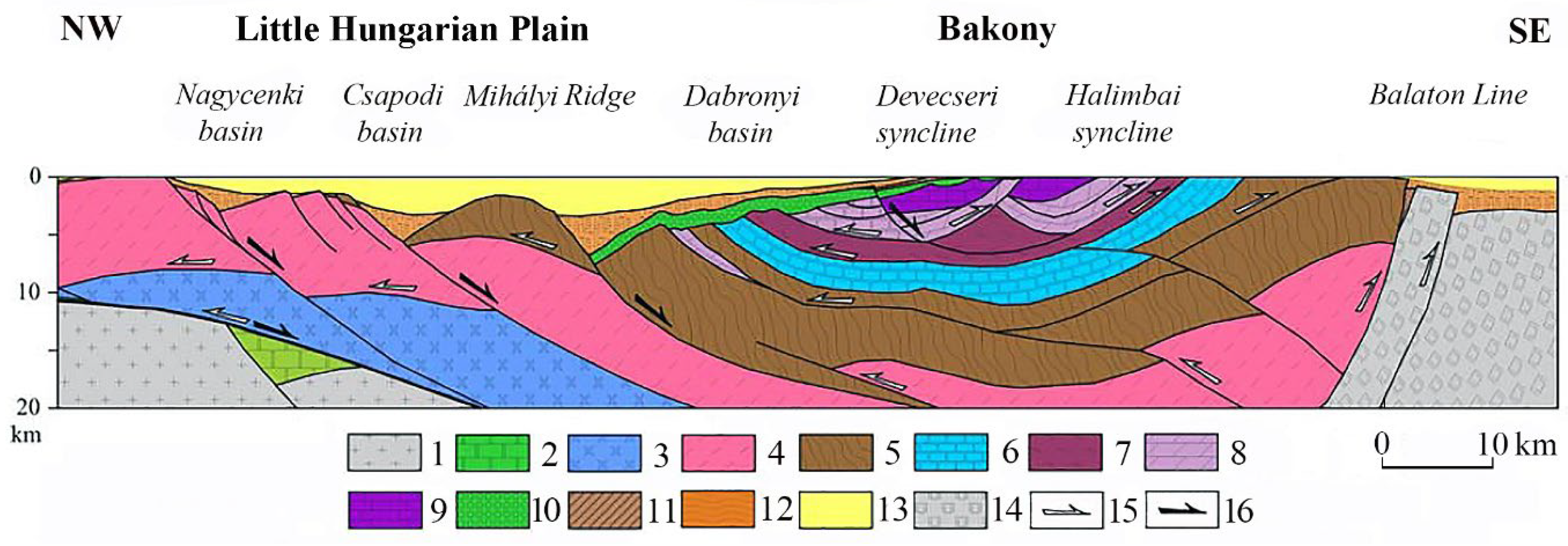
3. Methods
4. Results
| Profile | Mountains | Temperature (°C) | Reciprocal Gradient [m/°C] | Horizontal Specific Temperature (°C/1 km) | Direction of Water Motion | Water Temperature of Karst Springs | |
|---|---|---|---|---|---|---|---|
| Method a | Method b | ||||||
| A-A′ | Bakony Mountains (Hévíz) | 90 | 25 | 0.83 | 1.98 | upwelling | 40 °C [41] |
| B-B′ | Bakony Mountains | 90 | 25 | 0.37 | 0.35 | outflow | - |
| C-C′ | Bakony Mountains | 90 | 25 | 0.29 | 0.58 | outflow | - |
| D-D′ | Bakony Mountains | 90 | 25 | 0.79 | 1.06 | partly upwelling | Tapolcafő spring 18.5 °C [2] |
| E-E′ | Bakony Mountains (Tapolca) | 90 | 25 | 0.67 | 0.73 | partly upwelling | in a cave with a temperature of 18–20 °C-os at a depth of 152 m 42 °C [42] |
| H-H′ | Bakony Mountains, Keszthely Mountains (Hévíz) | 50 | 25 | 0.82 | 1.40 | upwelling | 40 °C |
| J-J″ | Bakony Mountains (near profile B-B′) | 50 | 25 | 0.62 | 2.08 | partly outflow | Tapolcafő spring 18.5 °C [2] |
| F-F′ | Buda Hills (Budapest) | 90 | 23.33 | 0.23 | 0.42 | ? | between 17–64.75 °C [43] |
| G-G′ | Buda Hills (Budapest) | 50 | 23.33 | 3.79 | 7.21 | upwelling | |
| Depth Difference (m) | Hydrostatic Pressure (Mpa) |
|---|---|
| 500 m | 4.905 |
| 1000 m | 9.911325 |
| 1500 m | 14.816325 |
| 2000 m | 19.721325 |
| 2500 m | 24.626325 |
| 3000 m | 29.531325 |
5. Discussion
6. Conclusions
Author Contributions
Funding
Data Availability Statement
Conflicts of Interest
References
- Szádeczky-Kardos, E. A Dunántúli középhegység karsztvízének néhány problémájáról (On some problems of the karst water of the Transdanubian Mountains). Hidrol. Közlöny 1941, 21, 67–92. (In Hungarian) [Google Scholar]
- Papp, F. Dunántúl karsztvizei és a feltárás lehetősége Budapesten (The karstwaters of Transdanubia and the opportunity of exploration in Budapest). Hidrol. Közlöny 1942, 21, 146–196. (In Hungarian) [Google Scholar]
- Keszler, H. Barlangok Mélyén (at the Bottom of Caves); Franklin Társulat: Budapest, Hungary, 1936; 134p. (In Hungarian) [Google Scholar]
- Pávai Vajna, F. A forró oldatok és gőzök-gázok szerepe a barlangképződésnél. (The roles of hot solutions and steams and gases in cave development). Hidrol. Közlöny 1930, 10, 115–122. (In Hungarian) [Google Scholar]
- Jakucs, L. A hévforrásos barlangkeletkezés földtani és fizikai tényezői (Geological and physical factors of thermal cave genesis). Hidrol. Közlöny 1948, 140, 53–58. (In Hungarian) [Google Scholar]
- Kovács, J.; Müller, P. A Budai-hegyek hévízes tevékenységének kialakulása és nyomai (Origin and traces of hydrothermal activities in the Buda Range). Karszt Barlang 1980, 2, 93–98. [Google Scholar]
- Mádlné Szőnyi, J.; és Tóth, Á. Basin-scale conceptual groundwater flow model for an unconfined and confined thick carbonate region. Hydrogeol. J. 2015, 23, 1359–1380. [Google Scholar] [CrossRef]
- Mádl-Szőnyi, J.; Erőss, A.; Csondor, K.; Iván, V.; Tóth, Á. Hydrogeology of the Karst Regions in Hungary. In Cave and Karst Systems of Hungary; Veress, M., Leél Őssy, S., Eds.; Springer: Cham, Switzerland, 2022; pp. 137–160. [Google Scholar]
- Leél-Őssy, S. Caves in the Buda Mountains. In Landscapes and Landforms of Hungary; Lóczy, D., Ed.; World Geomorphological Landscapes; Springer: Cham, Switzerland, 2015. [Google Scholar] [CrossRef]
- Mádl-Szőnyi, J.; Pulay, E.; Tóth, Á.; Bodor, P. Regional underpressure: A factor of uncertainty in the geothermal exploration of deep carbonates, Gödöllő Region, Hungary. Environ. Earth Sci. 2015, 74, 7523–7538. [Google Scholar] [CrossRef]
- Leél-Őssy, S.; Virág, M. The Caves of the Northeastern Part of the Transdanubian Mountains. In Cave and Karst Systems of Hungary; Leél Őssy, V., Ed.; Springer: Cham, Switzerland, 2022; pp. 361–413. [Google Scholar]
- Klimchouk, A.B. Hypogene Speleogenesis: Hydrogeological and Morphogenetic Perspective Special Paper No 1; National Cave and Karst Research Institute: Carlsbad, NM, USA, 2007; 106p. [Google Scholar]
- Klimchouk, A.; Palmer, A.N.; De Waele, J.; Auler, A.S.; Audra, P. Hypogene Karst Regions and Caves of the World; Springer: Cham, Switzerland, 2017. [Google Scholar]
- Goldscheider, N.; Mádl-Szonyi, J.; Erőss, A.; Schill, E. Review: Thermal water resources in carbonate rock aquifers. Hydrogeol. J. 2010, 18, 1303–1318. [Google Scholar] [CrossRef]
- Veress, M. Hydrological Characteristics of the Bakony Region (Hungary). Eng 2023, 4, 581–601. [Google Scholar] [CrossRef]
- Ford, D.C.; Williams, P.W. Karst Hydrogeology and Geomorphology; John Wiley & Sons Ltd.: Chichester, UK, 2007. [Google Scholar]
- Klimchouk, A. Speleogenesis-Hypogene. In Encyclopedia of Caves; White, B.W., Culver, D.C., Pipan, T., Eds.; Academic Press: Cambridge, MA, USA, 2019; pp. 974–988. [Google Scholar] [CrossRef]
- Kercsmár, Z.; Selmeczi, I.; Budai, T.; Less, G.; Konrád, G. Geology of the karst terrains in Hungary. In Cave and Karst Systems of Hungary; Veress, M., Leél-Őssy, S., Eds.; Springer: Berlin/Heidelberg, Germany, 2022; pp. 63–116. [Google Scholar]
- Schmidt Elegius, R. Geomechanikai szempontok a magyar mezozoós kratoszinklinálisok kialakulásához és főbb hegységszerkezeti vonásaik értelmezéséhez-Geomechanical point of views for the development of Hungarian Mesozoic cratogene synclines and for the interpretation of their main mountain structural characteristics. Foldt. Intez. Évkönyve 1961, 49, 747–758. (In Hungarian) [Google Scholar]
- Budai, T.; Konrád, G. Magyarország földtana (Geology of Hungary); Pécsi Tudományegyetem Pécs: Pécsi, Hungary, 2011; p. 102. (In Hungarian) [Google Scholar]
- Haas, J. A Budaörsi Dolomit Formáció, Fődolomit Formáció, Kösseni Formáció (The Budörs Dolomite Formation, Main Dolomite Formation, Kössen Formation). In Magyarország Litosztratigráfiai Alapegységei; Haas, J., Ed.; Triász, Földtani Intézet kiadványa: Budapest, Hungary, 1993. (In Hungarian) [Google Scholar]
- Gyalog, L. Magyarázó Magyarország Fedett Földtani Térképéhez (az Egységek Rövid Leírása) 1:100,000 (an Interpretation to the Covered Geological Map of Hungary, a Short Description of the Units); Magyar Állami Földtani Intézet: Budapest, Hungary, 2005; 189p. (In Hungarian) [Google Scholar]
- Haas, J.; Hámori, G.; Jámbor, Á.; Kovács, S.; Nagymarosi, A.; Szederkényi, T. (Eds.) Geology of Hungary; Eötvös University Press: Budapest, Hungary, 2001; 317p. [Google Scholar]
- Haas, J. Geological and Tectonic Background. In Landscapes and Landforms of Hungary; Lóczy, D., Ed.; Springer: Cham, Switzerland; Heidelberg, Germany; New York, NY, USA; Dordhrecht, The Netherlands; London, UK, 2015; pp. 7–17. [Google Scholar]
- Császár, G.; Csereklei, E.; Gyalog, L. A Bakony-Hegység Földtani Térképe (Szerk.) (Geological Map of the Bakony Mountains); Magyar Állami Földtani Intézet: Budapest, Hungary, 1981. (In Hungarian) [Google Scholar]
- Korpás, L. A Dunántúli-Középhegység Oligocén-alsó-Miocén Képződményei (Oligocene-Lower Miocene Features of the Transdanubian Mountains); MÁFI Évkönyve 64; Magyar Állami Földtani Intézet: Budapest, Hungary, 1981; 142p. (In Hungarian) [Google Scholar]
- Scheuer, G. A Budai termálkarszt pilisi szakaszának karsztvíz-földtani fejlődése a negyedidőszakban mészképző források alapján (The karstic hydrological evolution of the Pilis part of the Buda Thermal Karst on the basis of lime-forming thermal springs in the Quaternary period). Hidrol. Közlöny 2007, 87, 45–52. (In Hungarian) [Google Scholar]
- Kele, S.; Bódai, B. Age, depositional environment and geochemistry of freshwater carbonates (travertine, tufa) from Hungary. In Cave and Karst Systems of Hungary; Leél-Őssy, V., Ed.; Springer: Cham, Switzerland, 2022; pp. 513–533. [Google Scholar]
- Deák, M. Magyarázó Magyarország 200000-es földtani térképsorozatához, L-33-XII. In Veszprém (an Interpretation to the 200,000 Geological Map Series of Hungary, L-33-XII. Veszprém); Magyar Állami Földtani Intézet: Budapest, Hungary, 1972; 271p. [Google Scholar]
- Korpás, L. A Visegrádi-hegység (The Visegrád Mountains). In Pannon Enciklopédia; Karátson, D., Ed.; Kertek: Budapest, Hungary, 2000; pp. 327–328. (In Hungarian) [Google Scholar]
- Lóczy, L. A Balaton környékének geológiai képződményei és ezeknek vidékek szerinti telepedése (The geological features of the surroundings of Lake Balaton and their regional distribution). In A Balaton Tudományos Tanulmányozásának Eredményei; I.K. Magyar Állami Földtani Intézet: Budapest, Hungary, 1913; 617p. (In Hungarian) [Google Scholar]
- Jugovics, L. A Déli-Bakony és a Balaton-Felvidék Bazaltterületei (Basalt Terrains of Southern Bakony and of Balaton Uplands); Földtani Intézet Évi Jelentése 1953-Ról; Budapest, Hungary, 1954; pp. 65–88. (In Hungarian) [Google Scholar]
- Stegena, L.; Géczy, B.; Horváth, F. Late Cenozoic evolution of the Pannonian Basin. Tectonophysics 1975, 26, 71–90. [Google Scholar] [CrossRef]
- Bodor, P.; Erőss, A.; Mádl-Szőnyi, J.; Czuppon, G. A Duna és a felszín alatti vizek kapcsolata a Rózsadombi megcsapolási területen (Interaction between the ground-water and the Danube at the Rózsadomb discharge area. Karsztfejlődés 2014, 19, 63–75. [Google Scholar]
- Tóth, Á.; Mádl-Szőnyi, J. Where Does the Drinking Water Come From?–Interrelationship between Surface Water and Groundwater in a Carbonate Area, Hungary; EGU2019-8902; Geophysical Research Abstracts; EBSCO: Munich, Germany, 2019; Volume 21, p. 1. [Google Scholar]
- Csepregi, I. A karsztvízkiemelés hatása a Dunántúli-középhegység vízháztartására (The effect of karst water extraction on the water balance of the Transdanubian Mountains). In Bányászati Karsztvízszint-Süllyesztés a Dunántúli-Középhegységben; Alföldi, L., Kapolyi, L., Eds.; Magyar Tudományos Akadémia, Földrajztudományi Kutatóintézet: Budapest, Hungary, 2007; pp. 77–112. (In Hungarian) [Google Scholar]
- Mádlné-Szőnyi, J.; Erőss, A.; Havril, T.; Poros Zs Győri, O.; Tóth, Á.; Csoma, A.; Rochini, P.; Mindszenty, A. Fluidumok, áramlási rendszerek és ásványtani lenyomataik összefüggései a Budai-termálkarszton. (Fluids, flow systems and their mineralogical imprints in the Buda Thermal Karst). Földt. Közlöny 2018, 148, 75–96. (In Hungarian) [Google Scholar] [CrossRef]
- Alföldi, L.; Lorberer, Á. A karsztos hévizek háromdimenziós áramlásának vizsgálata kút adatok alapján (A study of the three-dimensional flow of karst rocks based on well data). Hidrol. Közlöny 1976, 56, 433–443. (In Hungarian) [Google Scholar]
- Tóth, A. Magyarország geotermikus felmérése a Magyar Energetikai és Közmű-Szabályozási Hivatal geotermikus projektjei tükrében (Geothermal survey of Hungary as regards of the Hungarian Energy & Utilities Regulatory Agency Geothermal projects). Magy. Tud. 2019, 180, 1822–1833. (In Hungarian) [Google Scholar] [CrossRef]
- Lenkey, L.; Dövényi, P.; Horváth, F.; Cloetingh, S.A.P.L. Geothermics of the Pannonian basin and its bearing on the neotectonics. In Neotectonics and Surface Processes: The Pannonian Basin and Alpine/Carpathian System; Cloetingh, S.A.P.L., Horváth, F., Bada, G., Lankreijer, A.C., Eds.; Stephan Mueller Special Publication Series; European Geosciences Union: Munich, Germany, 2002; Volume 3, pp. 29–40. [Google Scholar]
- Plózer, I. A Hévízi-tó forrásbarlangjának feltárása. (Exploration of the spring caves of Lake Hévíz). Karszt Barlang 1977, 65–66. (In Hungarian) [Google Scholar]
- Plózer, I. Adalékok a Tapolcai-tavasbarlang kutatásához (Data on the research of the Tapolca Lake Cave). Karszt Barlang 1975, 15–18. (In Hungarian) [Google Scholar]
- Ilosvay, L. 1893. Available online: https://www.arcanum.com/hu/online-kiadvanyok/OMMonarchia-az-osztrak-magyar-monarchia-irasban-es-kepben-1/budapest-394E/budapest-asvanyos-vizei-es-furdoi-ilosvay-lajostol-3E53/?list=eyJmaWx0ZXJzIjogeyJNVSI6IFsiTkZPX0tPTllfT01Nb25hcmNoaWFfMSJdfSwgInF1ZXJ5IjogImJ1ZGFwZXN0LWFzdmFueW9zLXZpemVpIn0 (accessed on 31 January 2023).
- Audra, P.; Palmer, A.N. Research frontiers in speleogenesis. Dominant processes, hydrogeological conditions and resulting cave patterns. Acta Carsolog. 2015, 3, 44. [Google Scholar] [CrossRef]
- Kárpát, J. A Cserszegtomaji-kútbarlang (The well cave of Cserszegtomaj). Karszt Barlang 1982, 1, 35–40. (In Hungarian) [Google Scholar]
- Láng, S. A Bakony geomorfológiai képe (The geomorphology of the Bakony Mountains). Földrajzi Közlemények 1958, 6, 325–343. (In Hungarian) [Google Scholar]
- Hoffer, A. A Tihanyi-félsziget vulkáni képződményei (Volcanic formations of the Tihany Peninsula). Földt. Közlemények 1943, 73, 375–429. (In Hungarian) [Google Scholar]
- Kovács-Pálffy, P.; Kalmár SVeress, M. A tihanyi-félsziget algás eredetű forrásüledékeinek ásvány-kőzettani vizsgálata. (Mineralogical-petrographic analyses of spring deposits of algal origin on the Tihany Peninsula). Karsztfejlődés 2007, 12, 121–135. (In Hungarian) [Google Scholar]
- Poros, Z.; Erőss, A.; Mádl-Szőnyi, J.; Mindszenty, A.; Molnár, F.; Ronchi, P.; Csoma, A.É. Mixing of karstic and basinal fluids affecting hypogene cave formation and mineralization in the Buda Thermal Karst, Hungary. In Proceedings of the IMA 2010 20th General Meeting of the International Mineralogical Association, Budapest, Hungary, 21–27 August 2010; Zaharia, L., Kis, A., Topa, B., Papp, G., Weiszberg, T.G., Eds.; Földtani Társulat: Budapest, Hungary, 2010; Volume 6, p. 465. [Google Scholar]
- Poros, Z.; Mindszenty, A.; Molnár, F.; Pironon, J.; Győri, O.; Ronchi, P.; Szekeres, Z. Imprints of hydrocarbonbearing basinal fluids on a karst system: Mineralogical and fluid inclusion studies from the Buda Hills, Hungary. Int. J. Earth Sci. 2012, 101, 429–452. [Google Scholar] [CrossRef]
- Hill, C.A. Geology of Carlsbad Cavern and other caves in the Guadalupe Mountains, New Mexico and Texas. New Mex. Bur. Mines Miner. Resour. Bull. 1987, 117, 150. [Google Scholar]
- Hill, C.A. Sulfuric acid speleogenesis of Carlsbad Cavern and its relationship to hydrocarbons, Delaware Basin, New Mexico and Texas. AAPG Bull. 1990, 74, 1685–1694. [Google Scholar]
- Hill, C.A. Sulpur redox reactions, native sulfur, Mississippi Valley type deposits, and sulfuric acid karst, Delaware Basin, New Mexico and Texas. Environ. Geol. 1995, 25, 16–23. [Google Scholar] [CrossRef]
- Müller, P. A metamorf eredetű széndioxid karsztkorróziós hatása (The karst corrosion effect of metamorphic carbon-dioxide). Karszt Barlang 1971, 2, 53–56. (In Hungarian) [Google Scholar]
- Auler, A.S.; Smart, P.L. The influence of bedrock derived acidity in the development of surface and underground karst: Evidence from the Precambrian carbonates of semi-arid Northeastern Brazil. Earth Surf. Process. Landf. 2003, 28, 157–168. [Google Scholar] [CrossRef]
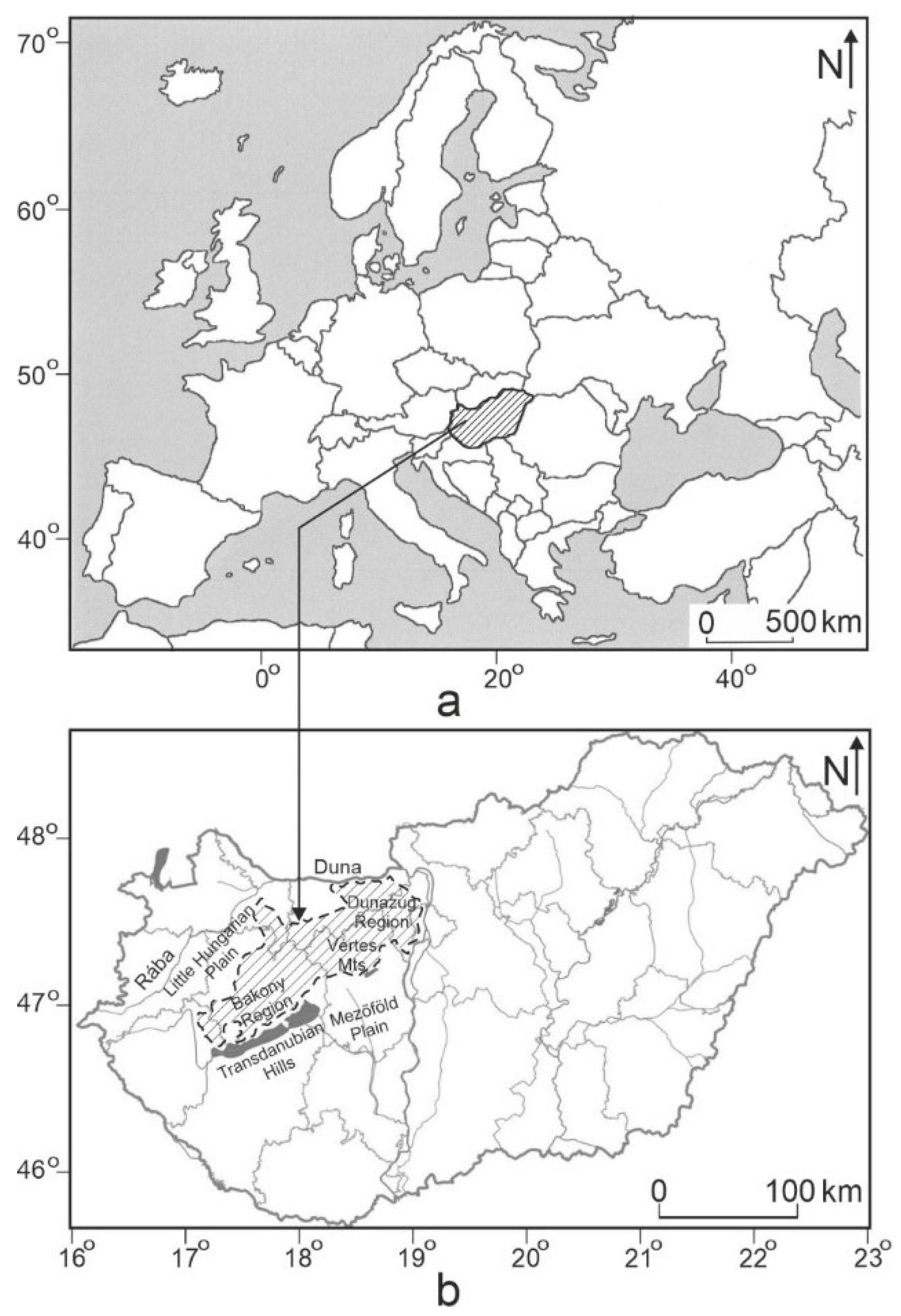



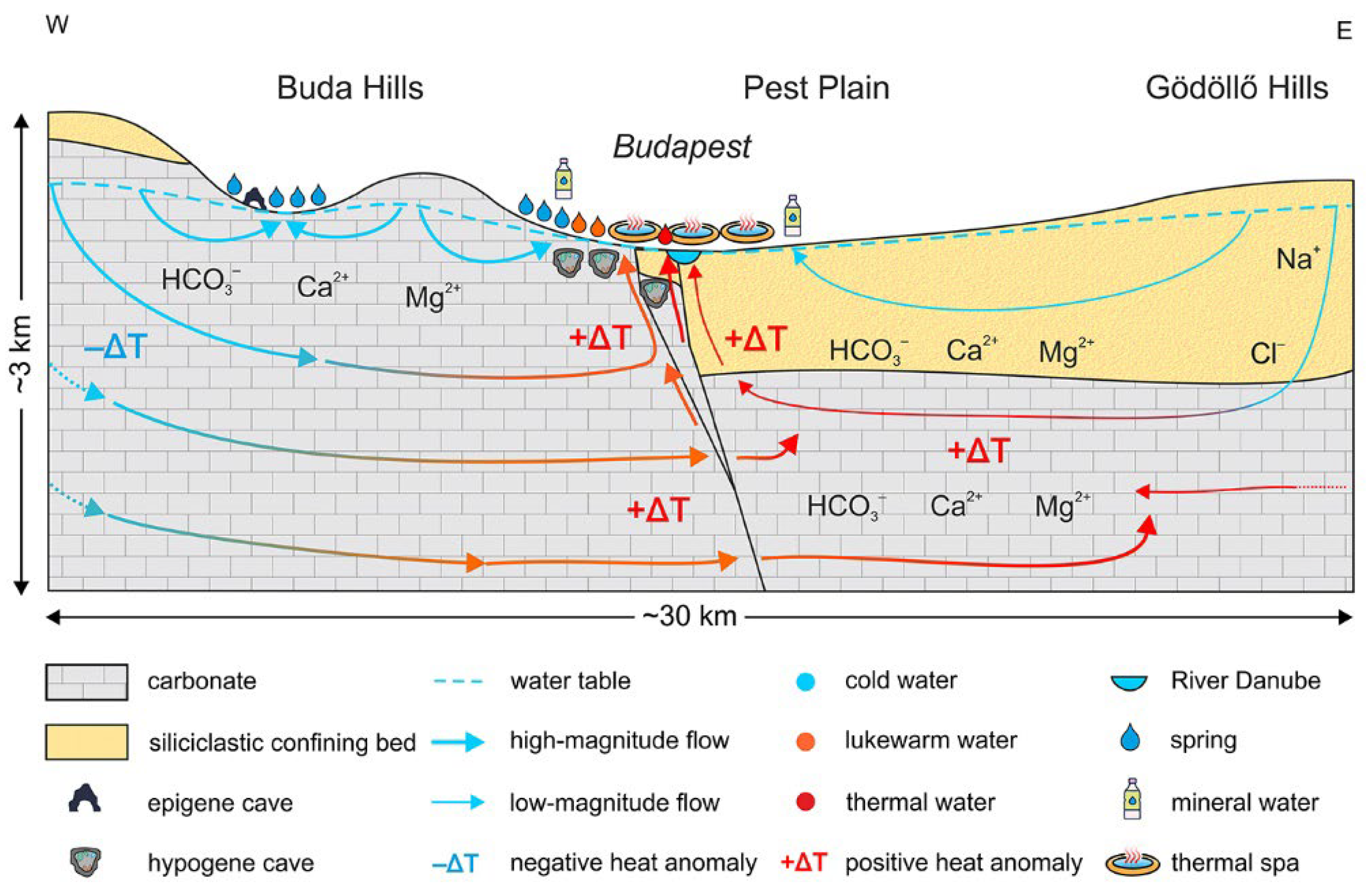
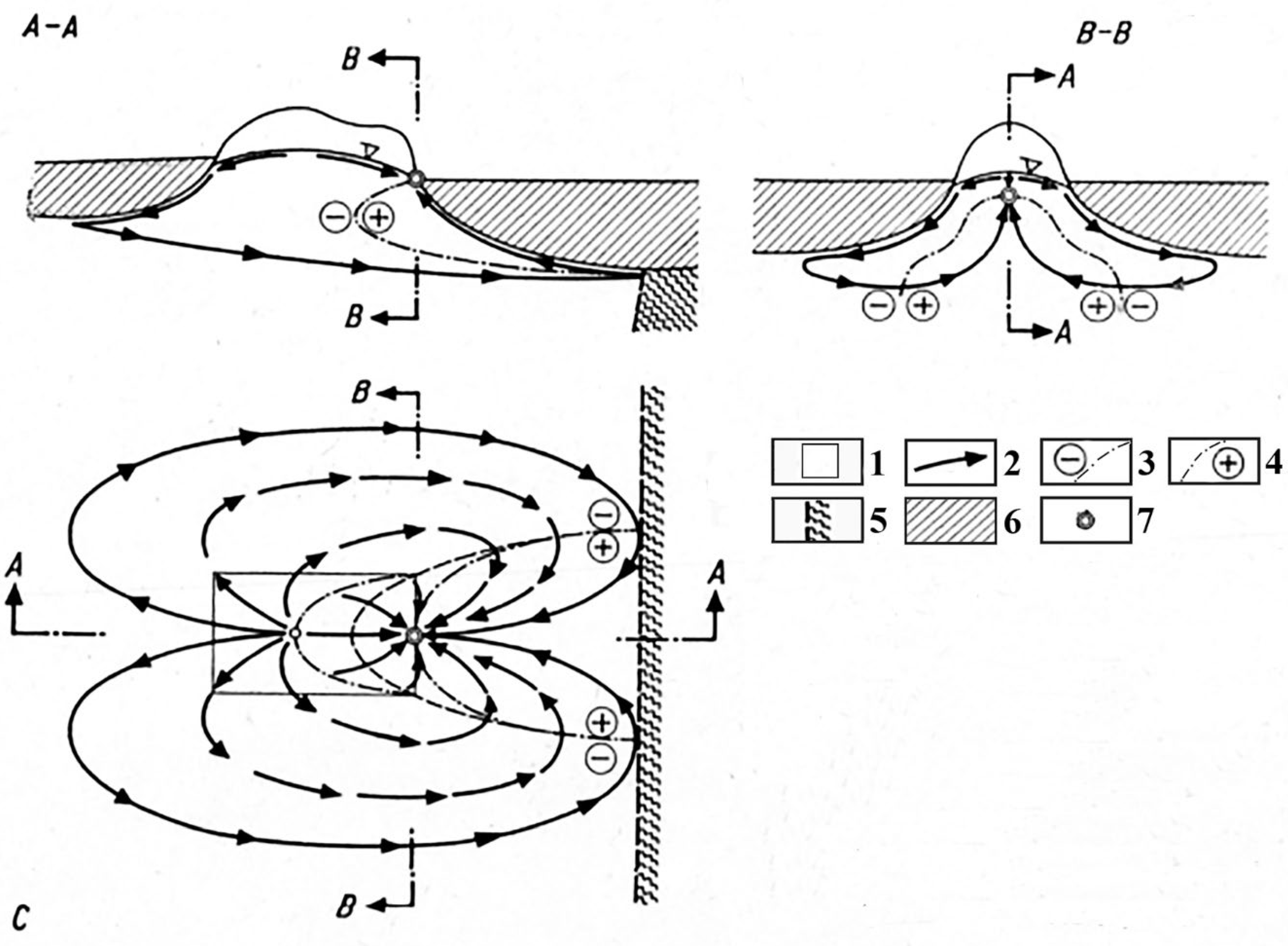




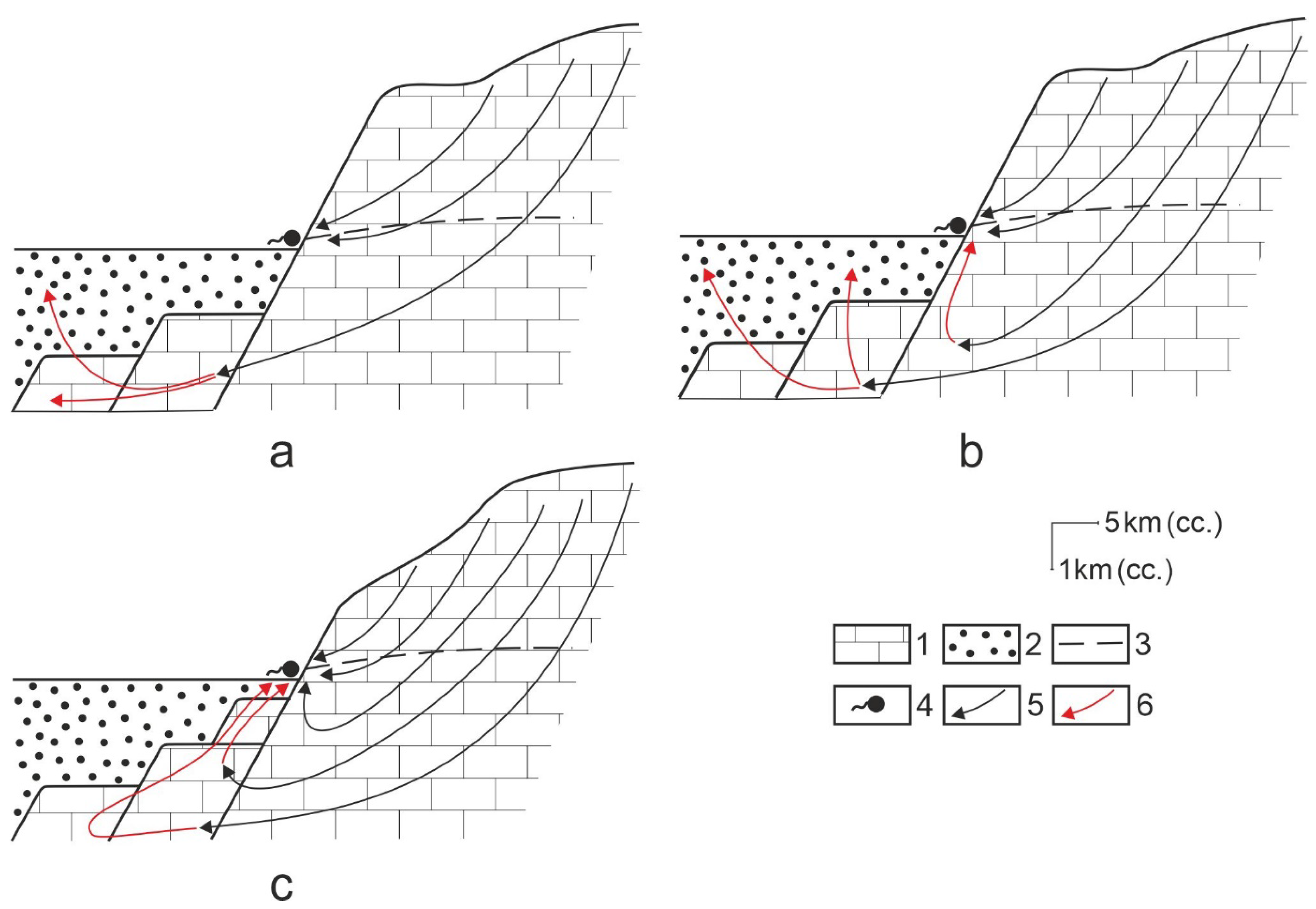
Disclaimer/Publisher’s Note: The statements, opinions and data contained in all publications are solely those of the individual author(s) and contributor(s) and not of MDPI and/or the editor(s). MDPI and/or the editor(s) disclaim responsibility for any injury to people or property resulting from any ideas, methods, instructions or products referred to in the content. |
© 2023 by the authors. Licensee MDPI, Basel, Switzerland. This article is an open access article distributed under the terms and conditions of the Creative Commons Attribution (CC BY) license (https://creativecommons.org/licenses/by/4.0/).
Share and Cite
Veress, M.; Péntek, K. The Effect of Horizontal Specific Temperature on the Flow Systems of the Transdanubian Mountains (Hungary). Hydrology 2023, 10, 145. https://doi.org/10.3390/hydrology10070145
Veress M, Péntek K. The Effect of Horizontal Specific Temperature on the Flow Systems of the Transdanubian Mountains (Hungary). Hydrology. 2023; 10(7):145. https://doi.org/10.3390/hydrology10070145
Chicago/Turabian StyleVeress, Márton, and Kálmán Péntek. 2023. "The Effect of Horizontal Specific Temperature on the Flow Systems of the Transdanubian Mountains (Hungary)" Hydrology 10, no. 7: 145. https://doi.org/10.3390/hydrology10070145
APA StyleVeress, M., & Péntek, K. (2023). The Effect of Horizontal Specific Temperature on the Flow Systems of the Transdanubian Mountains (Hungary). Hydrology, 10(7), 145. https://doi.org/10.3390/hydrology10070145






